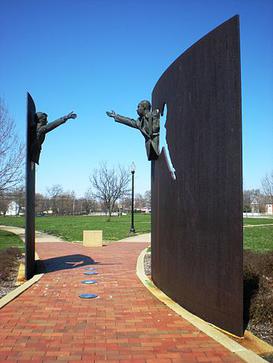Landmark for Peace Memorial facts for kids
Quick facts for kids Landmark for Peace Memorial |
|
|---|---|
 |
|
| Artist | Greg Perry and Daniel Edwards |
| Year | 1994 |
| Type | bronze and Cor-Ten steel |
| Location | Martin Luther King Jr. Park 1702 N. Broadway St. Indianapolis, Indiana, United States |
| 39°47′27″N 86°08′47″W / 39.79077°N 86.14637°W | |
| Owner | Indianapolis Parks and Recreation Department |
The Landmark for Peace is a special sculpture in Dr. Martin Luther King Jr. Park in Indianapolis. It was created to honor two important leaders: Martin Luther King Jr. and Robert F. Kennedy. The memorial shows King and Kennedy reaching out to each other. It was designed by Indiana artist Greg Perry, and the bronze faces were made by Daniel Edwards.
On April 4, 2018, this memorial was given a new official name: the Kennedy-King National Commemorative Site.
Contents
The Story Behind the Memorial
On April 4, 1968, Robert Kennedy arrived in Indianapolis. He was there for a speech to help his campaign to become president. When he landed, he learned that Martin Luther King Jr. had been killed.
Kennedy was told that riots had started in other cities. People advised him not to give his speech. But he decided to speak to the crowd gathered at 17th and Broadway streets. This is close to where the memorial stands today.
Instead of a campaign speech, Kennedy gave a short, powerful message. He told the crowd about King's death and asked everyone to come together. He urged people to avoid violence and work for peace. Many people believe that because of his speech, Indianapolis did not have riots like other cities.
How the Memorial Was Created
The idea for the Landmark for Peace came from Larry Conrad, a political leader from Indiana. He talked with Steve Mannheimer, an art critic and professor. They both felt it was important to remember the events of April 4, 1968. They especially wanted to honor Robert Kennedy's speech in Indianapolis.
Larry Conrad knew Herb and Diane Simon, who owned the Simon Property Group. Diane Simon had even worked on Kennedy's campaign. Conrad suggested that the Simon family might help if a memorial was created.
Starting the Project
In 1994, Donnie Walsh, who led the Indiana Pacers basketball team, started the Pacers Foundation. This foundation was created to support good community projects. Walsh talked with Steve Mannheimer, who shared the idea for the memorial.
Walsh immediately liked the idea. He thought it would be a perfect first project for the Foundation. Mannheimer and Kathryn Jordan from the Pacers worked together. They planned a national competition to find a design for the memorial. The Pacers and their Foundation helped raise money. Diane Simon gave $30,000 to start the project.
Choosing the Design
Experts like Bret Waller, director of the Indianapolis Museum of Art, helped choose the winning design. More than 50 artists from all over the country submitted ideas. The judges picked the design by Greg Perry, an artist from Franklin, Indiana.
Perry's design showed two half-figures, one of King and one of Kennedy. They seemed to come out of solid walls and reach toward each other. This design showed the importance of these two leaders. It also powerfully shared the message of peace and coming together.
On May 14, 1994, a special ceremony was held before construction began. Many important people attended, including President Bill Clinton, Senator Ted Kennedy, Robert Kennedy's wife Ethel Skakel Kennedy, and two of Martin Luther King Jr.'s sons, Dexter King and Martin Luther King III.
Building the Memorial
As the memorial was being built, the judges suggested some changes. They wanted the design to feel more open and welcoming. This included making the walls shorter and adding openings. These changes would allow people to see through the structure more easily.
Greg Perry worked with Steve Mannheimer and Daniel Edwards, who sculpted the figures of King and Kennedy. They made the design even better. To make the steel walls less heavy-looking, they decided to add cut-outs. These openings were shaped to look like shadows cast by the figures. Mannheimer drew the shapes on the walls, which were then cut out with lasers.
The total cost to create and install the memorial was about $200,000. This included two markers with bronze plaques. One plaque has the words from Kennedy's famous speech. Parts of this speech were later put on his own memorial at Arlington National Cemetery.
Another marker near where Kennedy spoke has pieces of guns. These guns were collected by the Indianapolis police or turned in by people during a city program. The competition for the memorial design required that these collected weapons be used in some way.
The City of Indianapolis also helped a lot. They completely redesigned the southern part of King Memorial Park where the sculpture stands. This added $350,000 to the project. The Indianapolis Parks and Recreation Department managed this work.
The Landmark for Peace memorial was officially revealed on September 30, 1995. Nearly 3,000 people came to see it.
On April 4, 2018, exactly 50 years after King's death and Kennedy's speech, President Donald Trump signed a law. This law officially named the Landmark for Peace memorial as the Kennedy-King National Commemorative Site.
Future Plans for the Memorial
In April 2009, plans were made for a $3 million expansion of the memorial. These plans included adding an eternal flame to the site. There would also be an amphitheater for 75 to 200 people. Twin walkways would be built along a wall. These walkways would suddenly end, symbolizing the sudden end of the lives of King and Kennedy.

